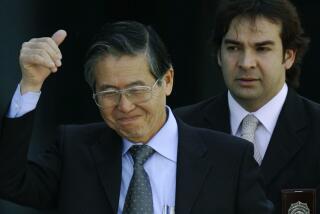INSURRECTION IN PANAMA : Chronology of Efforts to Oust Noriega
\o7 WASHINGTON\f7 — Tuesday’s coup attempt against Manuel A. Noriega is the latest in a series of futile efforts to dislodge the Panamanian strongman.
From the time he publicly seized power in 1983, opposition forces in Panama have tried to force him out by bullet and ballot box. Zealous U.S. prosecutors have sought his extradition to face drug-trafficking and money-laundering charges in Florida. Two U.S. administrations have sought to foment anti-Noriega unrest by imposing economic and diplomatic sanctions. But all efforts so far have failed, as the wily dictator has called on still-loyal forces within the Panamanian military to thwart the opposition.
Here is a chronology of major events in Panama’s recent history:
April, 1978--The U.S. Senate ratifies the Panama canal treaties, which will turn over the canal and U.S. military bases to Panamanian control on Dec. 31, 1999. In the interim, U.S. troops are based in Panama and provide security for the canal.
July, 1981--Panamanian dictator Gen. Omar Torrijos, who seized power in a 1968 coup, dies in a mysterious plane crash. His intelligence chief, Gen. Manuel A. Noriega, assumes control of the armed forces. Two years later, he declares himself supreme ruler of Panama. It is later learned that before and after Torrijos’ death, Noriega had been an informer for the CIA and, perhaps, other nations’ intelligence services.
May, 1984--Nicolas Ardito Barletta is elected president on a military-backed slate picked by Noriega. Opposition leaders allege fraud and intimidation in the voting.
September, 1985--Noriega removes Ardito Barletta from power and installs Eric A. Delvalle, former vice president and a Noriega loyalist.
June, 1987--Col. Roberto Diaz Herrera, ousted chief of staff of the Panamanian Defense Forces, accuses Noriega of election fraud, drug trafficking and involvement in the deaths of Torrijos and other political rivals. The National Civic Crusade, a coalition of 101 professional, labor and business groups, is formed to call for Noriega’s resignation.
February, 1988--Federal grand juries in Tampa and Miami indict Noriega on drug-trafficking charges. Later in the month, Noriega dismisses Delvalle and declares Manuel Solis Palma president. A four-day general strike paralyzes Panama City.
March, 1988--Opposition groups proclaim Delvalle president of a “government of national reconciliation.” President Ronald Reagan imposes economic sanctions against the “illegitimate” Noriega regime and freezes $7 million in canal revenues and all Panamanian assets held by U.S. banks.
March 16, 1988--Troops loyal to Noriega crush coup attempt led by Panama City Police Chief Col. Leonidas Macias.
April, 1988--The United States dispatches 1,300 troops to Panama to bolster security for U.S. service personnel and their dependents in Panama. Noriega calls the move a prelude to a U.S.-inspired coup.
September, 1988--Forces loyal to Noriega arrest 26 Panamanians for allegedly conspiring with the United States to mount an effort to topple the strongman.
May, 1989--Panama holds national elections, which foreign observers claim opposition candidates won by a large margin. Three days after the voting, thugs linked to Noriega attack opposition figures in Panama City after a rally celebrating their election victory. Panama’s Electoral Tribunal annuls the election results. Two days later, the first of 2,000 U.S. troops arrive at bases in Panama to provide security for Americans in the wake of continuing political demonstrations and repression.
Sept. 1989--Francisco Rodriguez, a Noriega ally, is inaugurated as provisional president under a deadline set by the Panamanian constitution.
Oct. 3, 1989--Rebellious junior military officers attempt to overthrow Noriega, but fail.
More to Read
Sign up for Essential California
The most important California stories and recommendations in your inbox every morning.
You may occasionally receive promotional content from the Los Angeles Times.








